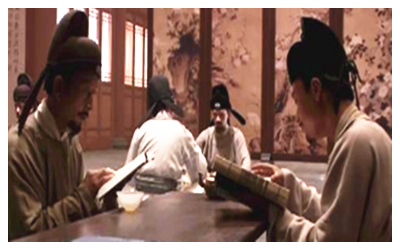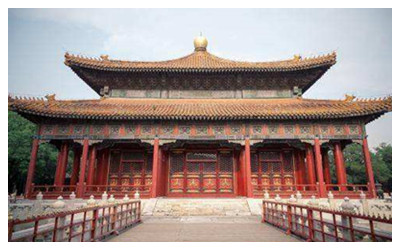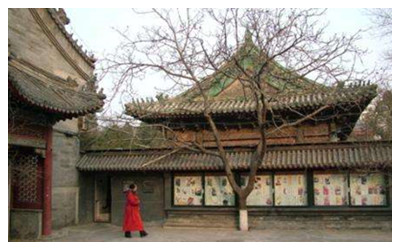
Hanlin Academy
 The Hanlin Academy began, as many great Chinese institutions did, back in the Tang dynasty. In 725, Emperor Xuanzong founded an academy within the Imperial Palace at Chang’an (present day Xi’an). It was originally open to all kinds of expert, not just scholars, including musicians and acrobats. Famous academicians from the early period include the great Tang poets Bai Juyi and Song Poet Su Shi (Su Dongpo).
The Hanlin Academy began, as many great Chinese institutions did, back in the Tang dynasty. In 725, Emperor Xuanzong founded an academy within the Imperial Palace at Chang’an (present day Xi’an). It was originally open to all kinds of expert, not just scholars, including musicians and acrobats. Famous academicians from the early period include the great Tang poets Bai Juyi and Song Poet Su Shi (Su Dongpo).
Only the brightest of students were chosen from the top 进士 jìn shì ‘Doctorate’ grade of state examinations. The primary function of the academy was to write the carefully phrased Imperial edicts but it had many other roles. On occasions academicians were called on to advise at times of crisis.
The Hanlin academy also provided tutors to both the Imperial family and top court eunuchs. As the top academic institution the scholars set and marked the state examination scripts, sometimes going out to the provinces to adjudicate on examination issues.
Academicians were often appointed to leading roles at other academies over the country to spread the love of learning. Perhaps more importantly they recorded a contemporary account of the acts of the Emperor. On the fall of a dynasty these records would form the official history of the preceding dynasty. The academy housed a magnificent library which held a prestigious collection of the finest books.
Over the dynasties the role of the Hanlin academy changed. Early on Tang Emperor Shenzong purged it of diviners, physicians and chess masters. It then became a pool of top advisers (a ‘think tank’). An academician was one of very few who had direct access to the Imperial Inner Court. For many aspiring members the academy was just an important stepping stone towards being appointed to a very lucrative role as a minister in the Imperial Secretariat. Academicians also worked on commentaries of the Confucian classics but the academy was not a Confucian institute, there were also scholars of Daoism and Buddhism. However, the key benefit of the appointment was the great respect and honour that it gave the holder, in this regard it resembled the Royal Society of London (founded 1660).
During the Song dynasty the academy lost some of its direct political influence and concentrated on cultural matters. In the following Yuan (Mongol) dynasty the famous painter of horses Zhao Mengfu became a director. The Mongol over-lords created a separate institution on similar lines to deal with all the Mongolian - Chinese translation work and let the Hanlin Academy concentrate on Han Chinese culture.
 When the Ming dynasty began in 1368 the academy was located at the capital Nanjing. The new Han Chinese dynasty gave the academy a much wider remit. In 1403 Emperor Yongle set the Hanlin academy upon its most famous and greatest task. He ordered a great encyclopedia to be written a much grander project the 永乐大典 Yǒng lè dà diǎn. When the Imperial court moved to Beijing in 1421 the academy was initially located just to the east of present day Tiananmen Square where it remained until its closure in 1911. It entered a golden age as the Imperial institution of arts and letters.
When the Ming dynasty began in 1368 the academy was located at the capital Nanjing. The new Han Chinese dynasty gave the academy a much wider remit. In 1403 Emperor Yongle set the Hanlin academy upon its most famous and greatest task. He ordered a great encyclopedia to be written a much grander project the 永乐大典 Yǒng lè dà diǎn. When the Imperial court moved to Beijing in 1421 the academy was initially located just to the east of present day Tiananmen Square where it remained until its closure in 1911. It entered a golden age as the Imperial institution of arts and letters.
When the Manchus came to power in 1644 they preserved the Hanlin Academy but created special entry for leading Manchu people by quota. It was necessary to train up skilled Chinese - Manchu translators and so some were admitted despite poor examination grades. In the great early phase of the Qing dynasty under Emperors Shunzhi, Kangxi, Yongzheng and Qianlong the academy prospered.
 Emperor Qianlong set the scholars on an even bigger project than the Yongle Dadian, this was the 四库全书 Sì kù quán shū ‘Complete Library of the Four Treasuries’ - the world’s largest ever paper-based encyclopedia. It began in 1773 and took 361 scholars nine years to produce 36,381 volumes - about 800 million characters in length. Four virtually complete copies of this great work have survived to the present day.
Emperor Qianlong set the scholars on an even bigger project than the Yongle Dadian, this was the 四库全书 Sì kù quán shū ‘Complete Library of the Four Treasuries’ - the world’s largest ever paper-based encyclopedia. It began in 1773 and took 361 scholars nine years to produce 36,381 volumes - about 800 million characters in length. Four virtually complete copies of this great work have survived to the present day.
In the last phase of the Qing dynasty, Lin Zexu came to pass the jinshi examination in 1811 and entered the academy. The scholar and military leader Zeng Guofan also attended to study at the academy.







 Ask Questions ?
Ask Questions ?